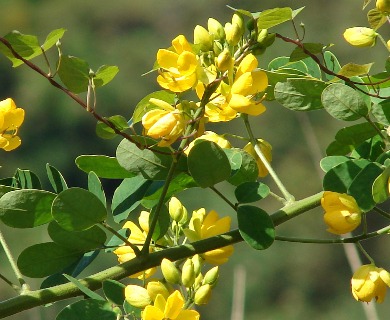Pendant Senna
Senna pendula
Pea family (Fabaceae)
Post-Cook introduction
This introduced tree planted in lowlands, especially along roadsides, has large showy clusters of numerous bright yellow flowers in late summer and many long narrow flat dark brown pods that remain attached and become unattractive. Medium-sized tree 60 ft (18 ) high with straight trunk and axis 1 ft (0.3 ) in diameter and erect Bark gray or light brown, smoothish, becoming slightly fissured. Inner bark is light brown, gritty and tasteless. Twigs are greenish and minutely hairy when young, turning brown.

©2007 Forest And Kim Starr
Flower clusters () are large, erect and 8–12 inches (20–30 ) or more in length and 5 inches (13 ) broad. Flowers are almost on straight yellow green finely hairy stalks of 1–1 1⁄4 inches (2.5–3 ). is composed of 5 concave pointed greenish yellow, finely hairy 5⁄16 inch (8 ) long; of five short-stalked spreading nearly equal bright yellow petals 5⁄8–3⁄4 inch (15–19 ) long; seven of different lengths and three smaller sterile and with pale green, minutely hairy one-celled and curved Flowering from July to October.
Pods, so numerous that they sometimes give an untidy appearance to the tree, are 6–10 inches (15–25 ) long, about 1⁄2 inch (13 ) broad, and 1⁄16 inch (1.5 ) thick, stiff and often slightly curved, splitting up sides into two parts. Seeds are many, beanlike, elliptical, 5⁄16 inch (8 ) long, shiny dark brown.
The sapwood is light brown and the heartwood dark brown. The wood is heavy ( gr. 0.75) and hard. It has a beautiful figure on flat-sawn faces imparted by prominent parenchyma tissue that is reminiscent of a pheasant’s tail, causing the wood frequently to be called “pheasant wood.” The wood, which is very susceptible to attack by dry-wood termites, is used for small turnery and carvings and is very popular. Elsewhere, it is employed for posts, fuel, construction, furniture, and similar purposes. Tannin has been extracted from the bark.
Only about 1500 trees have been planted in the Forest Reserves, almost all on Oahu. It is not commonly planted now as an ornamental because of the messy appearance of its pods. However, many old trees are still seen along roads and in old gardens. A prime example is a labeled tree near the ewa-makai gate of Iolani Palace grounds.
The species has been widely planted in Puerto Rico and the Virgin Islands in recent years for ornament, shade, and windbreaks. The trees form good windbreaks because they retain a deep closed They are propagated by seeds, grow very rapidly in full sunlight, and are suitable for fuel within a few years. However, they are very susceptible to attack by insects there.
The seeds, pods, and foliage are toxic to hogs and cause death quickly after being eaten. As hogs relish the poisonous leaves, farmers in Puerto Rico have suffered losses. Trees blown over or broken by storms increase the danger. Thus, swine and perhaps other livestock should be kept away from these trees.
Planted in lowlands, especially along roadsides in Hawaii and escaping. Introduced about 1865.
Special area
lolani
Range
Native of East Indies, Malaysia, India, and Sri Lanka, spread by cultivation. First described from Siam (now Thailand), as the common and scientific names indicate. Widely planted in the West Indies and naturalized locally. Planted also in southern Florida, Central America, and northern South America.
Other common names
kassod-tree, kolomona; casia de Siam (Puerto Rico)
Botanical
Cassia siamea Lam., Sciacassia siamea (Lam.) Britton
This species is known for its showy flowers in late summer after most legumes cease blooming. However, other species are generally more attractive.








